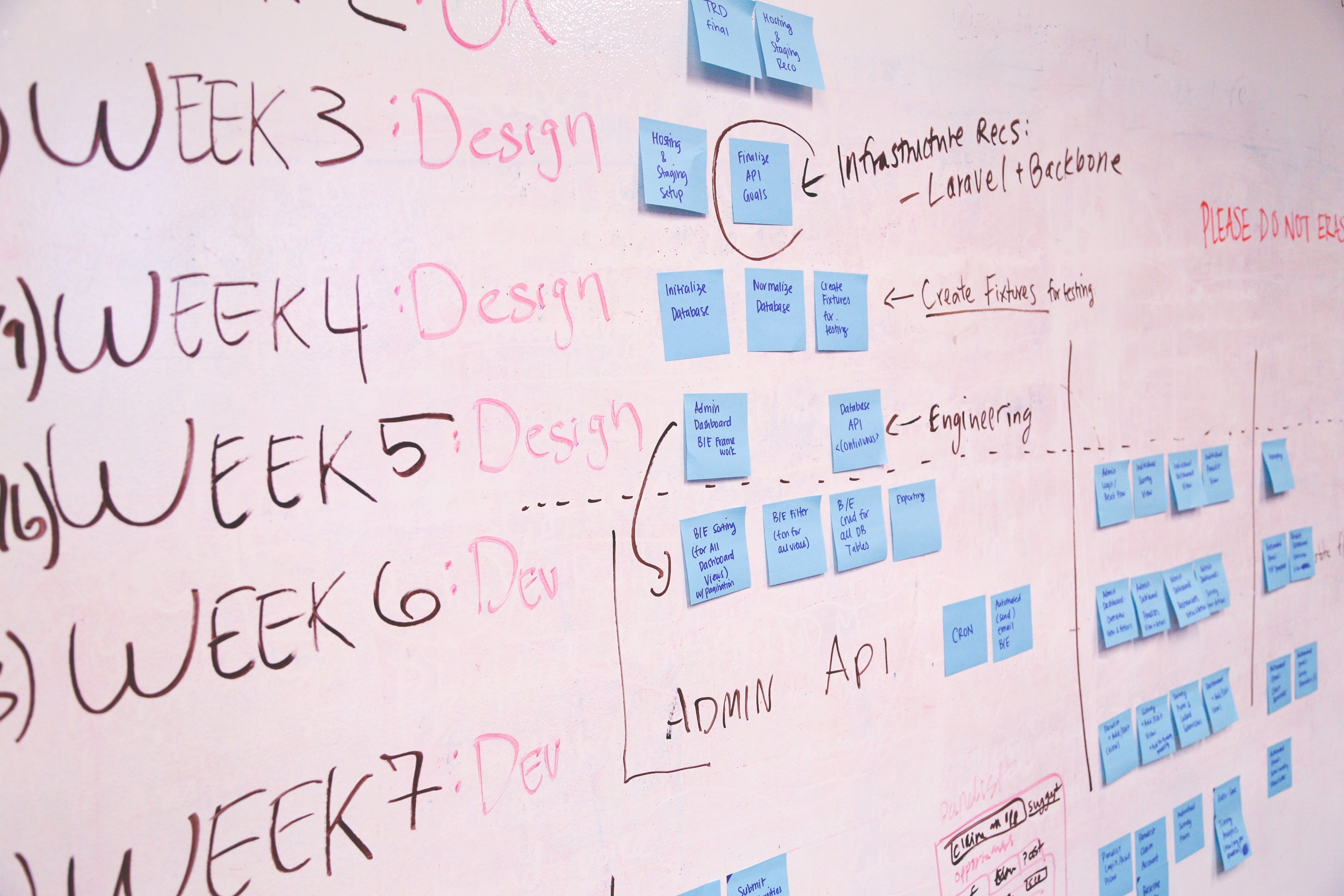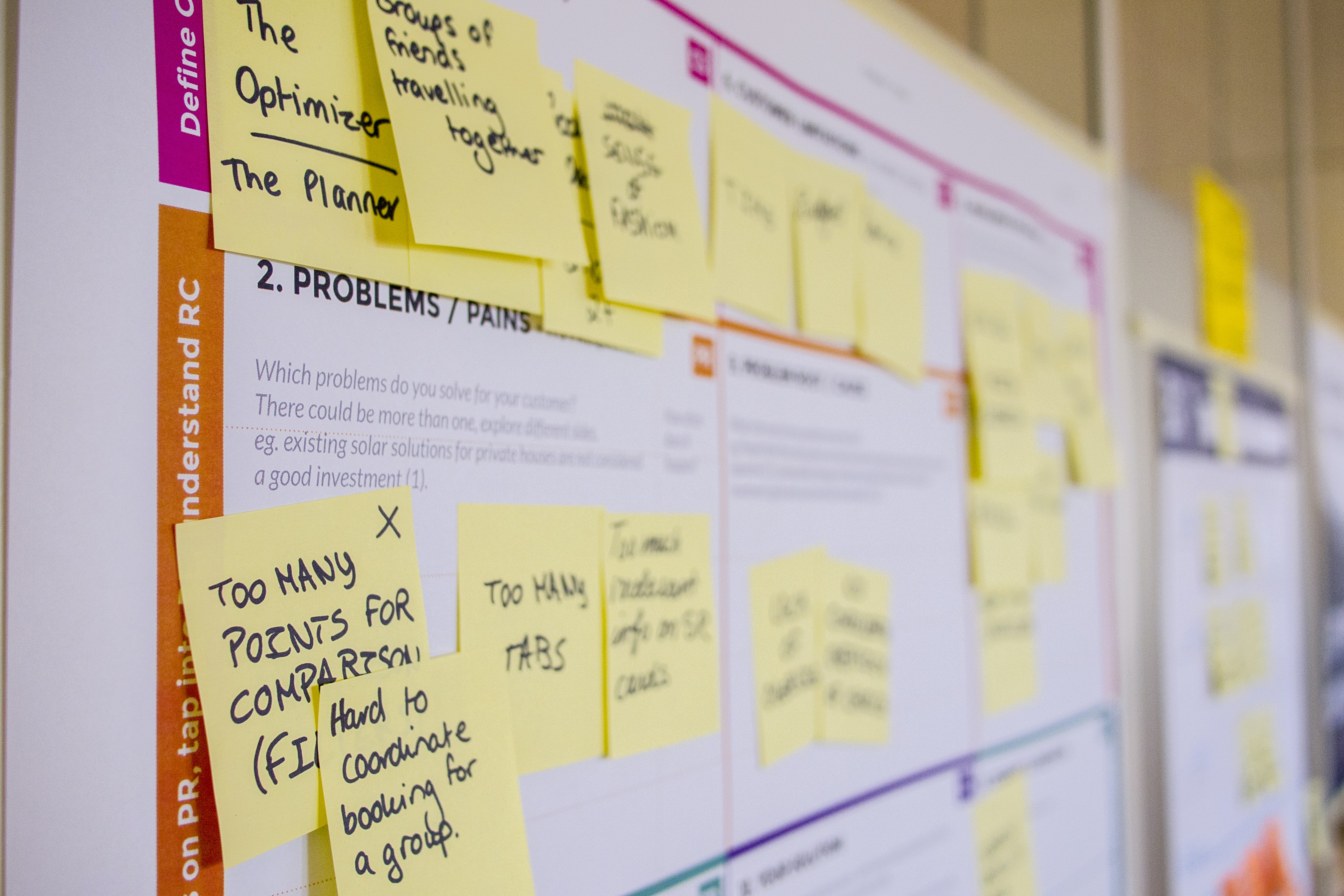Although every success story is different, there are a number of good practices to follow when creating a business solution.
What is the roadmap
for creating
a successful business solution?
04/02/2021

Get to know your users (personas)
The starting point for this roadmap is to know who you are trying to reach, who your users actually are.
To do this, you can draw up personas by listing the information you feel is relevant. Here are a few ideas of information you can gather :
- age
- gender
- occupation
- place of residence
- lifestyle
- personality
- frustrations
- wishes
Creating a typical user profile will enable you to define the habits and characteristics of your target audience so that you can develop a solution that is better adapted to their needs. Don't hesitate to draw up several personas if you identify a variety of user profiles.
To help you get to know and understand your users better, take a look at our article : The importance of user research.
To do this, you can draw up personas by listing the information you feel is relevant. Here are a few ideas of information you can gather :
- age
- gender
- occupation
- place of residence
- lifestyle
- personality
- frustrations
- wishes
Creating a typical user profile will enable you to define the habits and characteristics of your target audience so that you can develop a solution that is better adapted to their needs. Don't hesitate to draw up several personas if you identify a variety of user profiles.
To help you get to know and understand your users better, take a look at our article : The importance of user research.
Does your idea meet a need or a desire?
The aim is to ensure that you don't build your product or service around an idea, but around a problem that targets a major market. Even if your solution is aimed at a niche market.
Interviews, e-mails, messages on Linkedin, online questionnaires and targeted advertising on social networks are all good ways of doing it. Talk to your targets as quickly as possible to test your solution, gather feedback and validate the problem or pivot before moving on to the next stages.
At this stage, it's quite possible that your pitch isn't yet polished, and that's perfectly normal. Your pitch will become more impactful and concise with practice.
You can also design a landing page that you can share with your prospects to introduce them to your solution and collect e-mails from the first future users. There are a number of simple no-code tools for designing a landing page, such as Hubspot or Webflow.
Interviews, e-mails, messages on Linkedin, online questionnaires and targeted advertising on social networks are all good ways of doing it. Talk to your targets as quickly as possible to test your solution, gather feedback and validate the problem or pivot before moving on to the next stages.
At this stage, it's quite possible that your pitch isn't yet polished, and that's perfectly normal. Your pitch will become more impactful and concise with practice.
You can also design a landing page that you can share with your prospects to introduce them to your solution and collect e-mails from the first future users. There are a number of simple no-code tools for designing a landing page, such as Hubspot or Webflow.
Identify your competitors
When designing your landing, your solution or even your business model, it's important to know who your competitors are. You can then monitor and rework your positioning and the added value of your product in relation to your competitors.
To start with, a simple Google search using your project's main keywords will tell you about competitors who are already established. If the search doesn't turn up anything conclusive, then your idea might be innovative!
To start with, a simple Google search using your project's main keywords will tell you about competitors who are already established. If the search doesn't turn up anything conclusive, then your idea might be innovative!
Defining a Business Model

The Business Model Canvas is a visual tool widely used to describe and analyse a business model in a concise way. Here are the elements that are usually included and how they work together :
- Customer segment: determine who your customers are and what they want
- Value proposition: highlighting what makes products or services unique and valuable to customers and what differentiates them from the competition
- Distribution channels: methods used to contact customers and provide them with products and/or services
- Customer relations: how the company interacts with customers, such as personalised customer service or automated online services
- Revenue streams: ways in which the company makes money from selling products and/or services
- Key resources: fundamental elements the business needs to operate effectively, such as staff, finance and technology
- Key activities: the main actions involved in creating value, producing and distributing products and/or services, and managing customer relationships
- Key partners: external collaborators with whom the company works
- Cost structure: operating expenses, including fixed and variable costs
By paying attention to each element, it is possible to refine your commercial strategy to meet market needs more effectively, create a convincing value proposition and optimise your profitability.
- Customer segment: determine who your customers are and what they want
- Value proposition: highlighting what makes products or services unique and valuable to customers and what differentiates them from the competition
- Distribution channels: methods used to contact customers and provide them with products and/or services
- Customer relations: how the company interacts with customers, such as personalised customer service or automated online services
- Revenue streams: ways in which the company makes money from selling products and/or services
- Key resources: fundamental elements the business needs to operate effectively, such as staff, finance and technology
- Key activities: the main actions involved in creating value, producing and distributing products and/or services, and managing customer relationships
- Key partners: external collaborators with whom the company works
- Cost structure: operating expenses, including fixed and variable costs
By paying attention to each element, it is possible to refine your commercial strategy to meet market needs more effectively, create a convincing value proposition and optimise your profitability.
Designing your solution
In addition to the points we've just discussed, which mainly concern the marketing and strategy aspects of your project, you'll need to think about the design of the solution. We have chosen to focus on 2 main points that we have mastered at MobileThinking :
1) The design
Do it yourself or find a partner to design your business solution. Both can be viable to a certain extent. If design is not really your job, you can always take a pen and paper and sketch out the user flow (the path a user takes through an application, from its starting point to its final goal, showing the key stages and interactions) of your solution, even if it means writing down word for word what will be found on each interface.
Of course, if the exercise seems vague or complex, you can write specifications for your solution and send them to a design agency, which will create the first wireframes for you, which you will validate together as you go along.
Depending on your budget and, above all, the enthusiasm generated by the marketing, you will then have the choice of presenting your users with an interactive prototype produced by the design agency. This will allow your prospects to validate the solution before moving on to development.
Of course, if the exercise seems vague or complex, you can write specifications for your solution and send them to a design agency, which will create the first wireframes for you, which you will validate together as you go along.
Depending on your budget and, above all, the enthusiasm generated by the marketing, you will then have the choice of presenting your users with an interactive prototype produced by the design agency. This will allow your prospects to validate the solution before moving on to development.
2) The development

Below is a non-exhaustive list of the parameters that will influence the cost of developing your solution :
- What level of UI (User Interface) do you want?
In other words, the UI concerns the graphic environment in which the user will evolve (buttons, navigation, typography, visuals, etc.).
- How can the user register?
Do you want users to be able to register through an external service such as their Facebook or Twitter account, through an e-mail invitation or more formally with their e-mail address and password?
- Can an administrator manage user accounts?
Can a user be considered as an admin? This is often the case with SAAS solutions, where a "Super User" can manage user accounts.
Other settings :
- Can the user view data using a dashboard?
- Can they download content (images, video, files)?
- Is it possible to categorise information?
- Is it possible to share information with other users?
- Is there a map to geolocate a person or track a journey?
- Can users pay online?
The list goes on, but it is possible to iterate on the development of your solution by defining what is known as an MVP (Minimum Viable Product) in order to keep costs under control while including the basic functionalities.
After the development phase, and before the solution is published, a test phase is often planned to improve it and resolve any bugs.
- What level of UI (User Interface) do you want?
In other words, the UI concerns the graphic environment in which the user will evolve (buttons, navigation, typography, visuals, etc.).
- How can the user register?
Do you want users to be able to register through an external service such as their Facebook or Twitter account, through an e-mail invitation or more formally with their e-mail address and password?
- Can an administrator manage user accounts?
Can a user be considered as an admin? This is often the case with SAAS solutions, where a "Super User" can manage user accounts.
Other settings :
- Can the user view data using a dashboard?
- Can they download content (images, video, files)?
- Is it possible to categorise information?
- Is it possible to share information with other users?
- Is there a map to geolocate a person or track a journey?
- Can users pay online?
The list goes on, but it is possible to iterate on the development of your solution by defining what is known as an MVP (Minimum Viable Product) in order to keep costs under control while including the basic functionalities.
After the development phase, and before the solution is published, a test phase is often planned to improve it and resolve any bugs.
Conclusion
The roadmap for developing a successful solution is therefore complex in the sense that it requires you to juggle a number of areas in which you are not always an expert.
Whether you need to challenge your project and design your prototype by organising a Design Sprint, or take charge of the development of your product or service, you can count on our team of experts.
Whether you need to challenge your project and design your prototype by organising a Design Sprint, or take charge of the development of your product or service, you can count on our team of experts.


